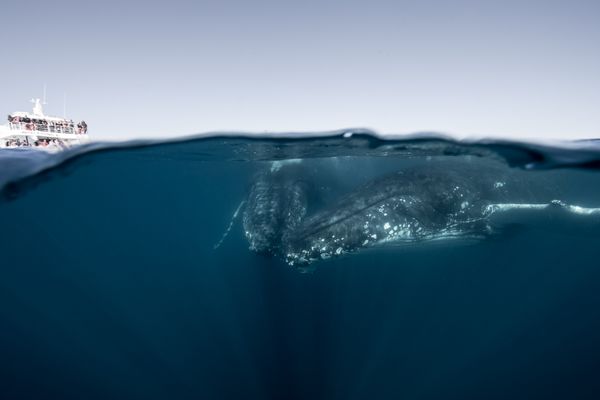
Hervey Bay is a top whale watching destination in Australia, not only for tourists but also for researchers who have revealed some quirky facts about the giant mammals.
Did you know humpbacks may sleep with one eye open, can stop blood flow to certain parts of their body, that sound is a more dominant sense than sight and that survival and gravity play a part in them growing to the size of a bus?
Pacific Whale Foundation senior research biologist Stephanie Stack said whales were conscious breathers which meant they had to think about going to the surface to take a breath.
“If they completely fell asleep, as humans do, they would not be able to surface and breathe,” she said.
Ms Stack said most sleep studies on marine mammals had been performed on dolphins in captivity and it was not really practical to put a humpback whale in a tank so researchers didn’t exactly know how whales slept but it was assumed they slept in a similar way to dolphins.
“It’s a process called unihemispheric slow-wave sleep: that means they ‘rest’ one half of their brain at a time while the other half remains alert,” she said.
“It’s thought they have relatively short periods of rest at one time, but have numerous periods of rest throughout the day and night – not one large chunk of time like we humans do.”
Dr Wally Franklin of the Oceania Project said it was possible humpbacks slept with one eye open because they had to remain conscious at all times and be alert to hazards and predators.
“They have conscious control over lots of different parts of their body,” he said.
“They can control blood flow.
“They have the ability to close off the flow of blood in an area of damage.”
Dr Franklin said that ability, combined with living in saltwater, helped them survive incredible flesh wounds from boat and propeller strikes and attacks by sharks and orcas.
He said the brains of whales were much larger and more complex than humans and sound was a more dominant sense for them than sight.
“They have a sound-processing capacity way beyond us,” Dr Franklin said.
He said whales could make sounds at frequencies higher and lower than humans could hear and could also emit incredibly loud sounds – equivalent to a rock concert!
“I’ve spent many hours out in the bay – we often listen to the whales at night,” Dr Franklin said.
“What we hear is an incredible cacophony of many whales singing.
“Those recordings are quite amazing to listen to compared to single whales.”
Hear the whale songs recorded off Fraser Island via facebook.com/oceania.
Ms Stack said whales had ears but not an external ear structure, just tiny openings which were difficult to see.
“The inner ear is generally similar to that of terrestrial mammals,” she said.
“Heavy wax inside the ear canal keeps water out and researchers can count dark and light rings in this plug of ear wax, like a tree trunk, to estimate how old a whale was when it died.”
Ms Stack said one of the new theories on why whales grew so big was to trap sufficient body heat to keep them warm in the ocean.
Dr Franklin said another factor was that humpbacks were not constrained by gravity so they could grow larger than what was possible on land.
“The natural condition of the whale is weightlessness,” he said.
“When they’re in the water, they don’t experience weight.
“When they breach, they do experience the weight of their body.
“It would be an incredible sensation.”
Dr Franklin said there were lots of other reasons for breaching including as a protection against sharks and killer whales and also a way to get their eye in their air to check out the location of vessels on the surface.
From late July to early November, humpback whales rest, relax, socialise and teach their youngsters life skills in the calm waters of Hervey Bay, protected by Fraser Island from ocean swells.
To find out how to join the researchers and other tourists watching humpback whales in Hervey Bay, go to whalesherveybay.com.au.
About Hervey Bay
- Hervey Bay is in Queensland’s south-east about a 3.5-hour drive or 35-minute flight from the State’s capital of Brisbane and a 90-minute direct flight from Sydney
- Unlike other whale watching locations, the humpbacks are not merely travelling past. They spend up to 10 days in Hervey Bay waters relaxing, playing, socialising and teaching their young calves life skills
- Whales in Hervey Bay are also inquisitive and lively, often approaching the boat and eyeballing the passengers, slapping their tails or fins on the surface and breaching
- The broad sweep of the bay is protected from ocean swells by the 123km length of Fraser Island, the world’s largest sand island, forming a naturally calm playground for the whales
- Late July and August are the best times to swim with the humpbacks in Hervey Bay but the whale watching season continues until early November





